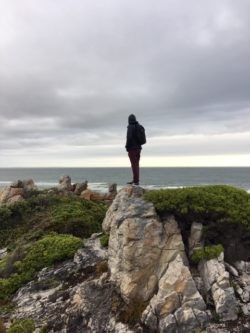
My Volunteering Experience at SCCT – Giacomo
 My name is Giacomo Distefano. I am 26 years old and I come from Bologna, Italy. I am a doctor and I am particularly interested in paediatric neuropsychiatry.
My name is Giacomo Distefano. I am 26 years old and I come from Bologna, Italy. I am a doctor and I am particularly interested in paediatric neuropsychiatry.
In the last few years, tired of hearing the same empty anti-migrant rhetoric, I started to be more and more attracted by the world of migration. For this reason, during the summer of 2018 I joined a volunteering program organised by the Scalabrinian Agency for Development and Cooperation (ASCS) in migrants’ informal settlement of Borgomezzanone in the South of Italy. After that, Through the international volunteer program offered by ASCS, I had the opportunity to take part in the programmes of Scalabrini Center of Cape Town (SCCT) from September to December 2019.
The experience I had at SCCT has not been the one that other volunteers usually have. In fact, I participated in three different projects offered by SCCT: Lawrence House, English School and Sihma.
I spent most of my time working at Lawrence House, a child and youth care centre specialised in the protection of unaccompanied foreign minors and refugee children. Volunteering there has sometimes been quite challenging. Indeed, the children who live there have gone through different kinds of traumas, especially during their way towards South Africa, that affect the way they behave and feel in their daily life. Inside the House, you can often feel the tensions, the difficulties, the disillusion. Yet, at the end of every day I spent at Lawrence House, I came home with a smile and a lesson learnt. Even though the girls and the boys are all very young, they often have such a life experience that can teach you much more than what you can teach them. Furthermore, spending time with them allowed me to have an overview of what integration between people from diverse cultural backgrounds really means. In Lawrence House, you can find in the same room children from DRC, Angola, Zimbabwe, Burundi, South Africa, playing together. In those moments, I noticed that something special takes place. One moment their differences suddenly show up, the moment after they suddenly disappear. When this type of situations happened, the only thing that I could do was to observe the beauty of it. In the end, I found volunteering at Lawrence House quite enlightening also because, I would like to become a paediatric neuropsychiatric and the House was the perfect place where to deepen my knowledge on certain psychological and psychiatric conditions. I really enjoyed listening to the children’s stories, helping them with the homework or simply playing with them.
At SCCT, I helped in the activities of the English School Programme. The English School curriculum is developed specifically for asylum seekers, refugees and migrants and is organised to assist them with integration in Cape Town. In the project, I worked as teacher assistant in the English literacy class, which included people with no knowledge of English. The commitment that these people put into learning a new language and their improvements they made from one week to another were incredible. Seeing someone previously unable to express themselves gradually becoming able to do so was like witnessing a person’s rebirth. Working at the English school was a great opportunity to understand the importance of communication in everyday life and to see first-hand the challenges and the sense of alienation people live during the migration process, starting from the difficulties they face in understanding a foreign language. I believe that the School is one of the most relevant projects at SCCT, as it is the one which gives migrants a real chance to be able to interact with the local community and thus, to integrate into the South African society.
The last part of my experience took place at the Scalabrini Institute for Human Mobility in Africa (SIHMA). SIHMA’s goal is to conduct and disseminate research that contributes to the understanding of human mobility and informs policies that ensure the rights and dignity of migrants, asylum seekers and refugees in Africa. At SIHMA, I mainly carried out research on specific migrations issues. For instance, I made an analysis on the form of refugee reception carried out in Uganda, which is characterised by the establishment of refugee settlements. Thanks to this research, I learned that refugee settlements focus on cohabitation and integration between refugees and local hosting communities, with the aim of improving the living conditions of both. I also realised that in Europe the form of refugee reception that is commonly used is predominantly a different one: the refugee camps. Although the world of research seems sometimes to have just a theoretical dimension, with no real practical implications, I strongly believe that this is not the case of SIHMA, where the research made inform better migration policies at the national and international level.
Overall, I can undoubtedly say that I had an amazing volunteering experience. I am deeply persuaded that I will always bring with me the people I met in Cape Town. The knowledge and the values that I developed will surely have an impact on my professional and personal life.
Categories:
Tags:

